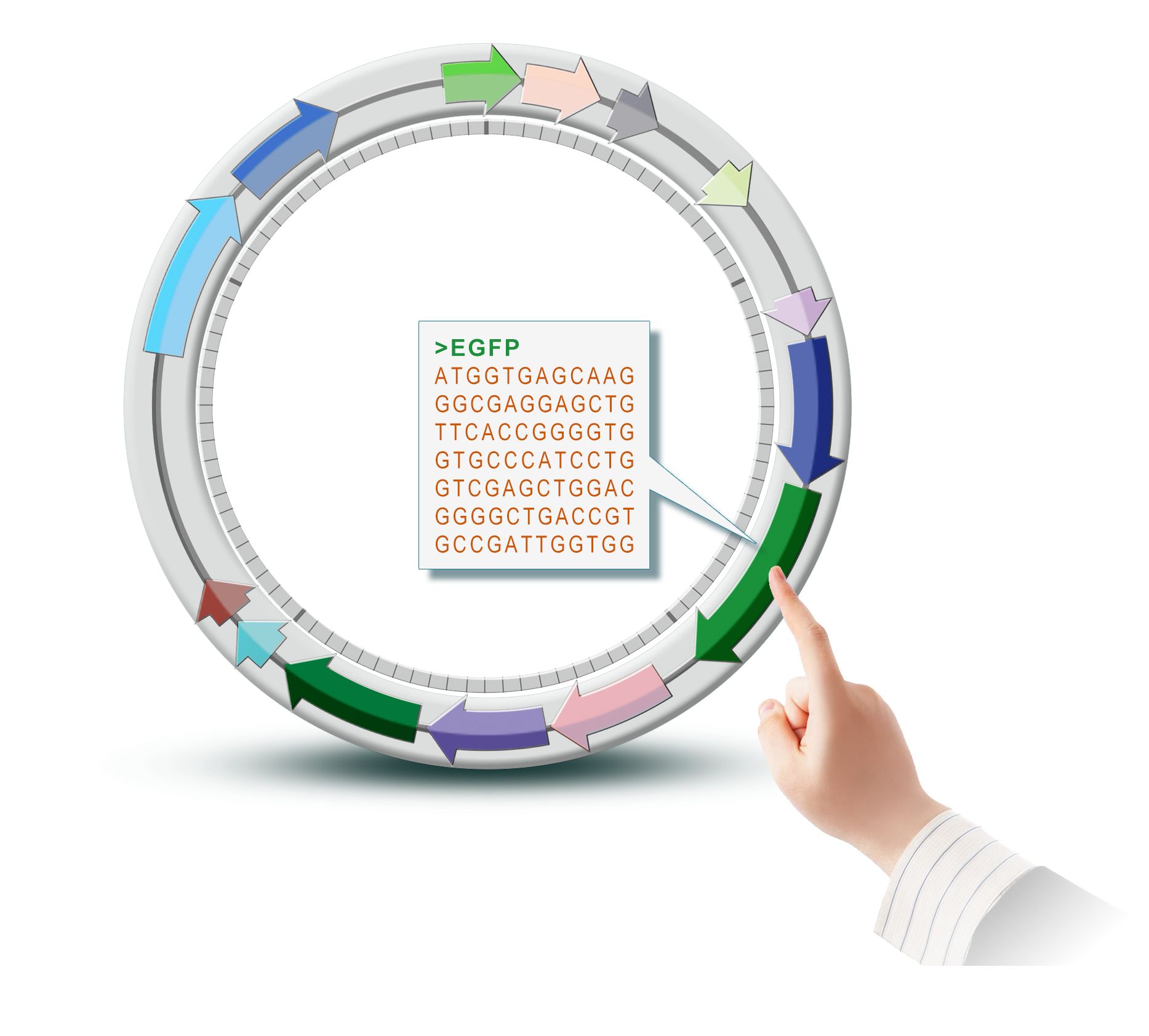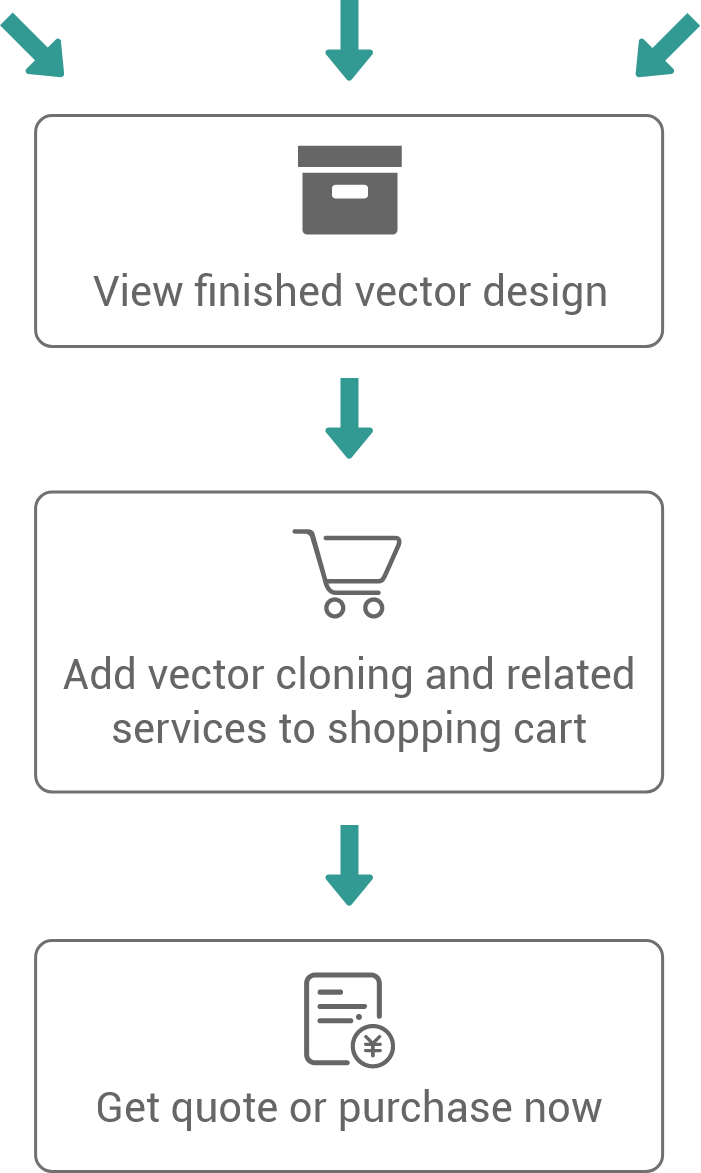Vector Cloning
Service Information
Price and turnaround Price Match
Our custom vector cloning workflow typically consists of three parts: QC of customer-supplied materials (if applicable), sourcing of required vector components (if applicable), and the actual vector cloning step. A brief overview of the price and turnaround breakdown is shown in Table 1 below:
Table 1. Overview of price and turnaround for custom cloning.
| Vector cloning* | Vector component sourcing (if applicable) | QC of customer-supplied materials (if applicable) | ||||
|---|---|---|---|---|---|---|
| Type | Depends on the complexity of vector design | In-stock template | Customer-supplied template | De novo gene synthesis | As vector backbone | As source for vector component |
| Price |
a. For shRNA, gRNA and short fragment expression (e.g. enhancer, promoter): starting from $149 b. For protein expression: starting from $189 |
$0-$50 for >80% of templates | $0 | Refer to Table 3 | $150 | Starting from $150 |
| Turnaround** | 1-3 weeks for >80% of the projects | Immediately available | Immediately available after passing QC | Refer to Table 3 | 3-5 days | |
| Description | Cloning methods include PCR, ligation-based cloning, Gibson, Gateway and Golden Gate cloning | In-stock templates include promoters, ORFs, markers, linkers and protein tags. | About 20% of projects need de novo gene synthesis | QC includes quantification, re-transformation, plasmid prep, RE digestion and Sanger sequencing. | ||
Note:
* Vectors built from VectorBuilder’s standard backbones and components have flat price and turnaround based on Table 2 below.
** The cloning turnaround refers to the time from production initiation to completion. It does not include transit time and QC of customer-supplied materials, and transit time for shipping final deliverable to the customer.
Table 2. Price and turnaround for simple vector cloning.
| Vector Type | Price | Turnaround |
|---|---|---|
| shRNA vector | $149 | 4-7 days |
| gRNA vector (single-gRNA) | $149 | 4-7 days |
| gRNA vector (dual-gRNA) | $329 | 6-12 days |
| Expression vector | $189 | 3-6 days |
Table 3. Price and turnaround for de novo gene synthesis.
| Fragment length | Price (USD)* | Turnaround |
|---|---|---|
| <1.5 kb | $0.12/bp | 5-10 days |
| 1.5-3 kb | $0.14/bp | 10-15 days |
| 3-5 kb | $0.17/bp | 10-20 days |
| 5-8 kb | $0.21/bp |
*The de novo gene synthesis fee may be higher when 1) the fragment contains regions that are difficult to synthesize such as high GC content, simple repeats or segmental repeats; 2) fewer than three DNA fragments are synthesized.
Deliverables
The default deliverable format is E. coli glycerol stock. Upon request, small amounts of plasmid DNA can be provided if available without additional charge. Multiple scales of high-quality plasmid DNA can be purchased additionally: Miniprep (> 10 ug), Midiprep (>100 ug), Maxiprep (> 300 ug), Megaprep (>1 mg) and Gigaprep (>10 mg). For viral vectors, virus packaging offered at various scales is available as a downstream service.
Quality control (QC)
All vectors cloned by VectorBuilder come with a 100% sequence guarantee. Our vectors undergo stringent quality control to ensure that they contain the correct sequence exactly as designed. Common QC includes DNA quantification, A260/280 measurement, electrophoresis of undigested and restriction enzyme digested plasmid DNA, Sanger sequencing, recovering bacteria from glycerol stocks, and re-transformation.
Customer-supplied materials
If customer-supplied materials such as backbones or gene templates are needed, please submit your materials information on "Support" > "Materials Submission Form". Please strictly follow our guidelines to set up shipment to avoid any delay or damage of the materials. All customer-supplied materials undergo mandatory QC by VectorBuilder which may incur an additional QC charge starting from $120 per item, depending on the type and usage of item. Please note that production cannot be initiated until customer-supplied materials pass QC.
FAQ
At VectorBuilder, a combination of various molecular biology techniques is utilized to generate custom vectors based on customer needs. While expression vectors are typically constructed using Gateway cloning or Gibson assembly, shRNA and gRNA vectors are cloned using a ligation-based approach to provide you with your desired vectors at the lowest prices and fastest turnaround times utilizing our highly optimized high-throughput cloning platform. Additionally, we routinely use a variety of other methods including de novo gene synthesis and Golden Gate cloning as needed, on a project-by-project basis.
All vectors at VectorBuilder are cloned using our proprietary host strain VB UltraStable™, which is designed to achieve high transformation efficiency (>1x109 cfu/ug) and for propagating DNA plasmids with unstable elements such as repeated sequences. Therefore, we highly recommend that you use VB UltraStable™ chemically competent cells for propagating your plasmids obtained from VectorBuilder. However, our vectors are compatible with and can be propagated in other commonly used bacterial hosts strains such as DH5α and Stbl3.
The origin of replication on your plasmid is for low-copy replication
The number of plasmid copies per bacterial cell is determined by the origin of replication on the plasmid. Some origins have inherent low copy number. Check the copy number of the origin of replication on your plasmid. For low-copy plasmids, increase the amount of E. coli culture for plasmid DNA prep in order to obtain satisfying DNA yield.
Check the copy number of the origin of replication of plasmids supplied by VectorBuilder
The volume of bacterial culture is too low for plasmid prep column
Please check the binding capacity of your plasmid prep column and whether your plasmid is high- or low-copy plasmid. For mini preps, we recommend that you harvest 1-5 ml of overnight bacterial culture. For maxi preps, if the plasmid is high-copy plasmid, we recommend using 100-150 ml of overnight bacterial culture; if the plasmid is low-copy plasmid, we recommend using 300-500 ml of overnight bacterial culture. Typically, for high-copy plasmid, ~5 ug of plasmid DNA can be extracted from every 1 ml of culture in mini prep and ~500 ug of plasmid DNA can be obtained from 150 ml of culture; for low-copy plasmid (e.g. pET), 1.5-2.5 ug of plasmid DNA can be harvested from every 1 ml of culture in mini prep and 150-200 ug of plasmid DNA can be obtained from 150 ml of culture.
Only a fraction of bacteria in the liquid culture contain plasmids
Some antibiotics, ampicillin in particular, degrade fast in liquid culture. As a result, bacteria that do not contain plasmids can propagate to a significant fraction of the culture, causing poor yield of the plasmid prep. To avoid this, please prepare ampicillin containing growth medium freshly before use and make sure that enough ampicillin is supplied. Also, when culturing ampicillin-resistant bacteria, do not let the liquid culture saturate for too long before harvesting. Besides insufficient antibiotics in the culture, extracting plasmid DNA from very old culture can also result in low yield, since many bacterial cells are dead and plasmid DNA they contain is degraded. Therefore, try to extract plasmid DNA from fresh culture. If plasmid prep cannot be performed immediately, you can spin down the bacteria and store the pellet in -80°C freezer for later plasmid prep.
The liquid culture is directly inoculated from E. coli stab culture
Direct inoculation of a liquid culture from the E. coli liquid stock or stab culture you have received from VectorBuilder can very occasionally result in low yield. We recommend streaking the stock onto an LB agar plate containing the appropriate antibiotic first, and then inoculating a liquid culture with a fresh colony growing from that plate. Detailed user instructions can be found by going to menu item Learning Center > Documentation > Stab Culture.
You have not carefully followed the manual of the plasmid prep kit
If you use a plasmid prep kit, please carefully read the manual before use. Improper operations can often lead to poor performance of the kit.
The mini/maxi prep column is low-quality
Some brands of plasmid DNA prep columns perform poorly or inconsistently for DNA preparation.





